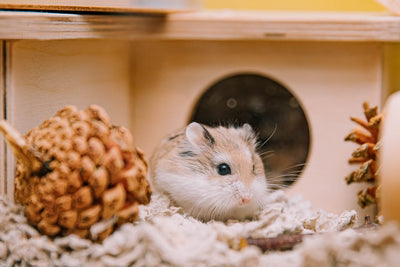
When it comes to caring for reptiles, providing live food options is essential for their health and well-being. In this guide, we will explore everything you need to know about offering live food to your scaly companions. From understanding the nutritional benefits of live prey to learning how to safely source and feed insects, worms, and other live foods, this comprehensive overview will help you make informed decisions for your reptile's diet. Whether you have a bearded dragon, a leopard gecko, or a snake, knowing the ins and outs of live food options will ensure that your pet receives the proper nutrients and enrichment they need to thrive. Join us as we delve into the fascinating world of live food choices for reptiles and discover the best practices for incorporating them into your reptile care routine.
Benefits of Live Food for Reptiles
Nutritional Advantages of Live Food Over Processed Alternatives
One of the key benefits of live food for reptiles is the nutritional advantages it offers over processed alternatives. Live food such as crickets, mealworms, and Dubia roaches are rich in essential nutrients like protein, vitamins, and minerals that are crucial for the health and well-being of reptiles. These live prey items provide a more natural and balanced diet compared to commercial reptile pellets or canned foods. In addition to the essential nutrients, live food also contains moisture, which helps in hydration, especially for reptiles that may not drink water readily from a dish. This natural source of hydration can contribute to the overall health of the reptile's digestive system and prevent issues like dehydration.
Promotion of Natural Hunting Behavior in Reptiles
Another significant advantage of feeding live food to reptiles is that it promotes their natural hunting behavior. In the wild, reptiles are predators that hunt for their food, and by offering live prey items, reptile owners can stimulate this instinctual behavior in their pets. Hunting for live food provides mental stimulation and physical exercise for reptiles, helping to prevent boredom and encourage natural behaviors. This hunting activity also allows reptiles to exhibit their natural predatory instincts, enhancing their overall well-being and mental health.
Variety and Enrichment in the Diet
Introducing a variety of live food options into a reptile's diet not only ensures nutritional diversity but also provides enrichment. Different prey items offer varying textures, tastes, and sizes, which can engage the reptile's senses and prevent dietary monotony. For example, offering a mix of crickets, mealworms, and waxworms can mimic the varied diet a reptile might encounter in the wild, promoting a more natural feeding experience. Additionally, the act of hunting and capturing different types of prey can mentally stimulate the reptile, preventing stress and encouraging natural foraging behaviors.
Incorporating live food into a reptile's diet can offer numerous benefits, including superior nutrition, hydration, the promotion of natural hunting behavior, and enrichment through dietary variety. Reptile owners should consider adding a diverse selection of live prey items to their pet's feeding routine to ensure a well-rounded and enriching diet that supports both physical health and mental well-being.
Types of Live Food for Reptiles
When it comes to feeding reptiles, providing live food is essential for their health and well-being. Different types of live food offer various nutritional benefits and can cater to the dietary needs of different reptile species. Let's explore some common types of live food that are suitable for reptiles:.
Insects:
- Crickets: A staple food for many reptiles, crickets are rich in protein and can be gut-loaded to enhance their nutritional value.
- Mealworms: These are a popular choice for reptile owners due to their ease of availability and high protein content.
- Dubia Roaches: Known for their soft exoskeleton, dubia roaches are a great source of protein and are easy to digest.
Worms:
- Superworms: Larger than mealworms, superworms are a good option for larger reptiles and provide a substantial amount of protein.
- Earthworms: Rich in nutrients, earthworms are a natural food choice for many reptiles and can help with digestion.
- Hornworms: With their high moisture content, hornworms are beneficial for keeping reptiles hydrated.
Other options:
- Pinkie Mice: Suitable for reptiles that require a higher fat content in their diet, pinkie mice are a good source of calcium and protein.
- Feeder Fish: Fish such as guppies or minnows can be offered as a treat for aquatic reptiles like turtles.
- Snails: Snails are a calcium-rich food option that can help supplement a reptile's diet.
In addition to the mentioned live food options, there are other choices that can provide a well-rounded diet for your reptile. Some reptiles may benefit from occasional treats like waxworms or locusts, which offer different nutritional profiles. It's crucial to consider the specific dietary requirements of your reptile species when selecting live food.
When feeding live food to your reptile, always ensure that the prey items are appropriately sized to prevent choking or digestive issues. Gut-loading the insects with nutritious foods before offering them to your reptile can enhance their nutritional value. Dusting the live food with calcium powder and other essential supplements is also important to prevent nutritional deficiencies.
Variety is key when it comes to feeding reptiles. Rotating between different types of live food can help prevent dietary imbalances and ensure that your reptile receives a diverse range of nutrients. Remember to monitor your reptile's feeding behavior and adjust their diet as needed based on their growth, activity level, and overall health.
For personalized dietary recommendations for your reptile, consult with a veterinarian or reptile specialist who can provide guidance based on your pet's specific needs and health status.
Feeding Tips and Guidelines
Feeding your reptile is a crucial aspect of their care, directly impacting their health and overall well-being. To ensure your scaly friend thrives, it's essential to follow these feeding tips and guidelines:.
- Gut-Loading Live Food for Optimal Nutrition
Gut-loading live food is a fundamental step in providing your reptile with essential nutrients. By feeding the live insects a nutritious diet before offering them to your pet, you enhance their nutritional value. Consider incorporating a variety of gut-loading foods such as dark leafy greens, squash, and oranges to boost the insects' nutrient content.
- Frequency and Portion Control When Feeding Live Food
Establishing a feeding schedule tailored to your reptile's species and age is vital. Avoid overfeeding, as it can lead to obesity and related health issues. Conversely, underfeeding may result in malnutrition. Monitor your pet's body condition regularly and adjust portion sizes accordingly. Remove any uneaten insects from the enclosure to maintain a clean environment.
- Supplementation and Calcium Dusting for Live Food
Apart from gut-loading, supplementing live insects with calcium powder is crucial, especially for reptiles with high calcium requirements. Calcium deficiencies can lead to serious health conditions like metabolic bone disease. Consult a reptile veterinarian to determine the appropriate supplementation schedule based on your pet's specific needs.
- Hydration and Moisture
In addition to a well-rounded diet, ensure your reptile has access to fresh water at all times. Some reptiles may require a humid environment to support proper shedding and hydration. Research your pet's species to provide the ideal humidity levels and hydration sources.
- Variety in Diet
Offering a diverse diet is key to meeting your reptile's nutritional needs. Incorporate a mix of live insects, vegetables, fruits, and occasionally, commercial reptile diets to ensure a balanced nutrient intake. Rotate food items to prevent dietary imbalances and offer enrichment.
- Temperature and Lighting Requirements
Maintaining proper temperature gradients and providing adequate UVB lighting is essential for your reptile's overall health. Different reptile species have specific temperature and lighting needs, so research your pet's requirements to create an optimal habitat.
- Behavioral Enrichment
Stimulate your reptile's natural behaviors by incorporating enrichment activities in their enclosure. This can include providing climbing structures, hiding spots, and interactive toys to keep your pet mentally and physically engaged.
By incorporating these feeding tips, supplementation guidelines, and additional care considerations into your reptile's routine, you can ensure they lead a healthy and fulfilling life. Remember, a well-cared-for reptile is a happy companion that will bring you joy for years to come!.
Safety Precautions
Ensuring the safety and well-being of your animals is paramount. This is especially true when it comes to their diet and living conditions. In this section, we will explore some essential safety precautions that every exotic pet owner should be aware of.
Avoiding Potential Risks Associated with Live Food
One common practice among exotic pet owners is feeding live food to their animals. While this can be a natural and enriching experience for the pet, it also comes with certain risks. Live food, such as insects or rodents, can potentially harm your pet if not handled properly. To avoid any mishaps, always supervise feeding sessions and never leave live food unattended in the enclosure. Additionally, ensure that the live food is from a reputable source to minimize the risk of introducing parasites or diseases to your pet.
Proper Quarantine and Hygiene Practices
Introducing a new pet into your existing collection can be exciting, but it also poses a risk of spreading diseases. To prevent the transmission of illnesses, always quarantine new arrivals for a period of time before introducing them to other animals. This quarantine period allows you to observe the new pet for any signs of illness and prevents potential outbreaks among your existing pets. Moreover, maintaining proper hygiene practices is crucial in safeguarding the health of your pets. Regularly clean and disinfect enclosures, food and water dishes, and any other equipment used for your pets. Wash your hands thoroughly after handling any animals or their belongings to prevent the spread of germs.
Environmental Safety Measures
Apart from food and hygiene, ensuring the overall safety of your exotic pets' environment is essential. Check enclosures regularly for any wear and tear that could pose a risk to your pets. Make sure that all heating and lighting equipment is functioning correctly to provide a comfortable and safe habitat. Avoid using any toxic plants or materials in the enclosure that could be harmful if ingested. Creating a secure and enriching environment for your pets not only promotes their well-being but also reduces the likelihood of accidents or health issues.
Emergency Preparedness
Despite taking preventive measures, emergencies can still occur. It is crucial for exotic pet owners to be prepared for unexpected situations. Have a designated emergency kit that includes essential supplies such as first aid items, contact information for a vet experienced with exotic animals, and a list of common signs of illness in your pets. Familiarize yourself with emergency procedures specific to your pets' species, such as how to safely handle them in case of injury or escape. Being proactive and informed can make a significant difference in the outcome of emergencies involving your exotic pets.
Conclusion
Prioritizing safety precautions is fundamental in providing a secure and nurturing environment for your exotic pets. By being vigilant in handling live food, implementing proper quarantine and hygiene practices, ensuring environmental safety, and preparing for emergencies, you can significantly reduce the risks associated with exotic pet ownership. Remember that the well-being and longevity of your pets depend on the care and precautions you take, so always stay informed and proactive in safeguarding their health and happiness.
Conclusion
Understanding the importance of providing live food options for reptiles is crucial for their overall health and well-being. By offering a variety of live prey that aligns with their natural diet, reptile owners can ensure that their pets receive the necessary nutrients and enrichment. It is essential to research and select appropriate live food options based on the species of reptile being cared for, as well as considering factors such as size, nutritional value, and safety. Ultimately, incorporating live food into a reptile's diet can contribute to their physical health, mental stimulation, and overall quality of life.






